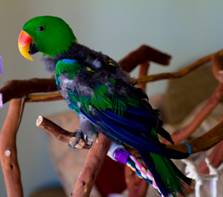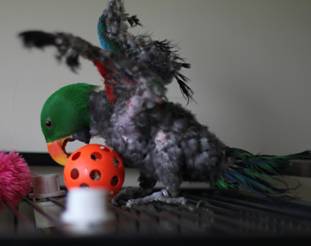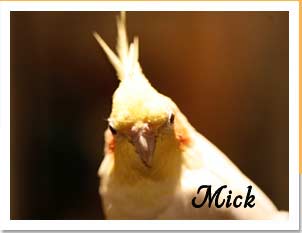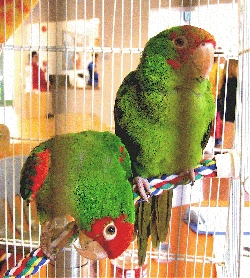First Aid for a Seizing Bird – An Owner’s Experience
By Amanda Samford
 |
It was a normal afternoon in my home, when I decided to break routine and get Monty, my Eclectus, out of cage during the lunch hour. He was sitting on his playstand, happy as could be while I sliced fruit in the kitchen. I looked over when I heard a strange noise - it was clearly coming from Monty, but was the eek of a voicebox muscle that was paralyzed. Monty was hanging by one foot, upside down (and not doing his swingy-swinga bird), like a bat. I pried his single foot from its death grip and held him to my chest. |
His eyes were half shut and unresponsive, but he was breathing. His feet were clenched up and he wouldn't perch - he was frozen solid. He came out of the seizure very slowly. First, his eyes began blinking, then his head was able to move a smidge...and finally, after two or three minutes, his feet began to unclench. It wasn't for a good five minutes afterwards that he made any move on his own out of my arms.
Thankfully, within moments I had the carrier out, lined with a towel and was dialing the avian vet's office, an eight minute drive from my home. Not everyone is so fortunate. So what can you do until you can see an avian veterinarian?
Very important: stay calm when responding to your bird's condition. Remember, our birds can sense our stress. Panicking will not help the situation. If necessary, call a friend to drive you to the veterinary office.
1. Secure the bird. If they are seizing in an area where they could potentially fall or be injured, remove them immediately. Get them into a quiet environment away from the other members of the flock or family. Dim the lights, and prepare a smaller cage or carrier in which they may rest. Forego the perches and put a thick towel in the bottom. In my situation, I was very concerned about the seizure ending and Monty possibly falling to the ground and sustaining an injury.
2. Bring the bird’s blood sugar back up. Seizures take up lots of energy, so it's recommended to keep something like Karo syrup on hand. Other recommended liquids are those high in sugar like Pedialyte, orange juice, or Gatorade. Replacing the electrolytes is beneficial. Use syringes (sans needles) to put the liquid into their beak after they have come out of the seizure if they will not drink it themselves. Do not give liquids to an unresponsive bird - they may aspirate the liquid.
3. Offer food and water if the bird will take it - do this inside the carrier. If possible, offer them something (like grapes or apple slices) with sugar and moisture in it.
4. Find the bird’s most recent poop and prepare to take it to the vet with your bird. The poop can help your vet run tests for various causes.
 Our vet was unable to determine a cause for Monty's seizure. He had lead and zinc tests performed, as well as complete bloodwork, gram stain, and an x-ray. Monty thankfully has gone six months without a seizure or any indication thereof, so we suspect it was some kind of environmental cause such as contaminated food.
Our vet was unable to determine a cause for Monty's seizure. He had lead and zinc tests performed, as well as complete bloodwork, gram stain, and an x-ray. Monty thankfully has gone six months without a seizure or any indication thereof, so we suspect it was some kind of environmental cause such as contaminated food.
No one expects their bird to ever have a seizure. That said, I hope these steps will help you know what to do if your bird ever has one.
(Editor’s Note: See this article for a clinical view of bird seizures.)

